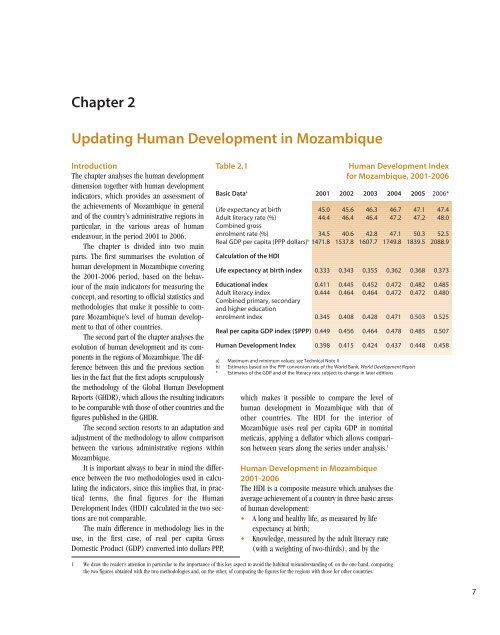English language version - Human Development Reports - United ...
English language version - Human Development Reports - United ...
English language version - Human Development Reports - United ...
- No tags were found...
Create successful ePaper yourself
Turn your PDF publications into a flip-book with our unique Google optimized e-Paper software.
Chapter 2Updating <strong>Human</strong> <strong>Development</strong> in MozambiqueIntroductionThe chapter analyses the human developmentdimension together with human developmentindicators, which provides an assessment ofthe achievements of Mozambique in generaland of the country’s administrative regions inparticular, in the various areas of humanendeavour, in the period 2001 to 2006.The chapter is divided into two mainparts. The first summarises the evolution ofhuman development in Mozambique coveringthe 2001-2006 period, based on the behaviourof the main indicators for measuring theconcept, and resorting to official statistics andmethodologies that make it possible to compareMozambique’s level of human developmentto that of other countries.The second part of the chapter analyses theevolution of human development and its componentsin the regions of Mozambique. The differencebetween this and the previous sectionlies in the fact that the first adopts scrupulouslythe methodology of the Global <strong>Human</strong> <strong>Development</strong><strong>Reports</strong> (GHDR), which allows the resulting indicatorsto be comparable with those of other countries and thefigures published in the GHDR.The second section resorts to an adaptation andadjustment of the methodology to allow comparisonbetween the various administrative regions withinMozambique.It is important always to bear in mind the differencebetween the two methodologies used in calculatingthe indicators, since this implies that, in practicalterms, the final figures for the <strong>Human</strong><strong>Development</strong> Index (HDI) calculated in the two sectionsare not comparable.The main difference in methodology lies in theuse, in the first case, of real per capita GrossDomestic Product (GDP) converted into dollars PPP,Table 2.1which makes it possible to compare the level ofhuman development in Mozambique with that ofother countries. The HDI for the interior ofMozambique uses real per capita GDP in nominalmeticais, applying a deflator which allows comparisonbetween years along the series under analysis. 1<strong>Human</strong> <strong>Development</strong> in Mozambique2001-2006The HDI is a composite measure which analyses theaverage achievement of a country in three basic areasof human development:• A long and healthy life, as measured by lifeexpectancy at birth;• Knowledge, measured by the adult literacy rate(with a weighting of two-thirds), and by the<strong>Human</strong> <strong>Development</strong> Indexfor Mozambique, 2001-2006Basic Data a 2001 2002 2003 2004 2005 2006*Life expectancy at birth 45.0 45.6 46.3 46.7 47.1 47.4Adult literacy rate (%) 44.4 46.4 46.4 47.2 47.2 48.0Combined grossenrolment rate (%) 34.5 40.6 42.8 47.1 50.3 52.5Real GDP per capita (PPP dollars) b 1471.8 1537.8 1607.7 1749.8 1839.5 2088.9Calculation of the HDILife expectancy at birth index 0.333 0.343 0.355 0.362 0.368 0.373Educational index 0.411 0.445 0.452 0.472 0.482 0.485Adult literacy index 0.444 0.464 0.464 0.472 0.472 0.480Combined primary, secondaryand higher educationenrolment index 0.345 0.408 0.428 0.471 0.503 0.525Real per capita GDP index ($PPP) 0.449 0.456 0.464 0.478 0.485 0.507<strong>Human</strong> <strong>Development</strong> Index 0.398 0.415 0.424 0.437 0.448 0.458a) Maximum and minimum values: see Technical Note IIb) Estimates based on the PPP con<strong>version</strong> rate of the World Bank, World <strong>Development</strong> Report* Estimates of the GDP and of the literacy rate subject to change in later editions1 We draw the reader’s attention in particular to the importance of this key aspect to avoid the habitual misunderstanding of, on the one hand, comparingthe two figures obtained with the two methodologies and, on the other, of comparing the figures for the regions with those for other countries.7
















